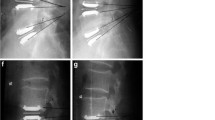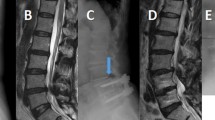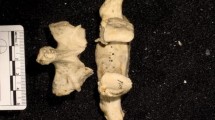Abstract
The purpose of this longterm follow-up was (1) to investigate disc changes in the olisthetic segment in patients treated conservatively, (2) to compare disc changes above the slipped vertebra in conservatively treated patients with those in operatively treated patients, and (3) to establish possible relations of disc changes to the degree of the slip and to subjective back pain symptoms of the patients. The subjects were 227 patients with isthmic L5 olisthesis diagnosed under 20 years of age (mean 13.8 years) with a mean follow-up of 15.4 (range 5–30) years. Of these, 145 patients had been treated with segmental fusion and 82 had been treated conservatively. At follow-up, standing anteroposterior and lateral radiographs as well as flexion/extension views of the lumbar spine were taken. Disc degeneration was graded semiquantitatively: 0 = normal disc height, 1 = decrease of disc height < 50%, 2 = decrease ≥50%, and 3 = obliteration of the disc. In the conservatively treated patients degeneration of the olisthetic disc was distributed by grade as follows: 0:n = 38, 1:n = 24, 2:n = 14, 3:n = 6. No motion at all was observed in the olisthetic segment in 40 patients (48%) with a mean slip of 30%,, segmental motion of 4°–18° was found in 42 patients with a mean slip of 14%. There was a statistically significant association of the degree of slip to the severity of disc degeneration and non-mobility of the segment. Grade 1 degeneration of the L4/5 disc occurred in 25.6% of the conservatively treated patients and in 32% of 48 patients treated with L5-S1 fusion. This correlated with the severity of the slip, but not with pain symptoms or pathologic segmental mobility at the time of follow-up. Out of 84 patients with L4-S1 fusion, in 17% grade 1 degeneration of the L3/4 disc was observed, and 3 out of 13 patients (23%) with L3-S1 fusion had grade 1 degeneration of the disc above the fusion. The disc changes had no correlation with subjective pain symptoms. It is concluded that the natural course of isthmic spondylolisthesis is associated with disc degeneration and spontaneous stabilization of the olisthetic segment. Fusion operations do not significantly increase the rate of disc degeneration in the adjacent disc above the fusion after a mean postoperative follow-up of 13.8 years. No correlation between the number of degenerated discs or the degree of degeneration and subjective low back pain symptoms was found.
Similar content being viewed by others
References
Anderson CE (1956) Spondyloschisis following spine fusion. J Bone Joint Surg [Am] 38:1142
Andersson GBJ, Schultz A, Nathan A, Irstam L (1981) Roentgenographic measurement of lumbar intervertebral disc height. Spine 6:154–158
Battié MC, Videman T, Gibbons LE, Fisher LD, Manninen H, Gill K (1995) Determinants of lumbar disc degeneration. Spine 20:2601–2612
Harris RI, Wiley JJ (1963) Acquired spondylolysis as a sequel to spine fusion. J Bone Joint Surg [Am] 45:1159
Hayes MA, Howard TC, Gruel CR, Kopta JA (1989) Roentgenographic evaluation of lumbar spine flexion-extension in asymptomatic individuals. Spine 14:327–331
Hensinger RN (1989) Current concepts review. Spondylolysis and spondylolisthesis in children and adolescents. J Bone Joint Surg [Am] 71:1098–1107
Kirkaldy-Willis WH (1983) The pathology and pathogenesis of low back pain. In: Kirkaldy-Willis WH (ed) Managing low back pain. Churchill Livingstone, New York Edinburgh London, pp 23–43
Laurent LE, Einola S (1961) Spondylolisthesis in children and adolescents. Acta Orthop Scand 31:45
Penning L, Blickman JR (1980) Instability in lumbar spondylolisthesis. A radiologic study of several concepts. Am J Roentgenol 134:293–301
Saraste H (1984) Spondylolysis and spondylolisthesis. Thesis, University of Stockholm, Stockholm
Schlenzka D, Poussa M, Seitsalo S, Österman K (1991) Intervertebral disc changes in adolescents with isthmic spondylolisthesis. J Spinal Disord 4:344–352
Schlenzka D, Seitsalo S, Poussa M, Österman K (1993) Premature disc degeneration: source of pain in isthmic spondylolisthesis in adolescents? J Pediatr Orthop [B] 1:153–157
Seitsalo S (1990) Operative and conservative treatment of moderate spondylolisthesis in young patients. J Bone Joint Surg [Br] 72:908–913
Tertti MO, Salminen JJ, Paajanen HEK, Terho PH, Kormano MJ (1991) Low-back pain and disc degeneration in children: a case-control MR imaging study. Radiology 180:503
Unander-Scharin L (1950) On lowback pain with special reference to the value of operative treatment with fusion. Acta Orthop Scand [Suppl] 5
White AA, Panjabi MM (1990) Clinical biomechanics of the spine, 2nd edn. Lippincott, Philadelphia, pp 561–565
Wiltse LL (1961) Spondylolisthesis in children. Clin Orthop 21:156–163
Zippel H (1980) Wirbelgleiten in Lendenbereich. Barth, Leipzig
Author information
Authors and Affiliations
Rights and permissions
About this article
Cite this article
Seitsalo, S., Schlenzka, D., Poussa, M. et al. Disc degeneration in young patients with isthmic spondylolisthesis treated operatively or conservatively: A long-term follow-up. Eur Spine J 6, 393–397 (1997). https://doi.org/10.1007/BF01834066
Received:
Revised:
Accepted:
Issue Date:
DOI: https://doi.org/10.1007/BF01834066




